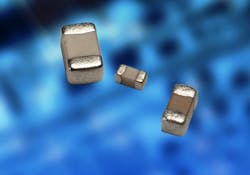C0G (NP0) MLCCs Add Capacitance Values, Voltage Ratings
AVX Corp. has expanded its range of high reliability C0G (NP0) dielectric multilayer ceramic capacitors (MLCCs). Available in case sizes spanning 01005 to 2225, voltages up to 500 V, and capacitance tolerances as low as ±0.1 pF, AVX's C0G (NP0) MLCCs provide one of the most stable capacitor dielectrics available in today's market, making them ideal for resonant circuit applications requiring superior stability or a precise temperature coefficient, such as: matching circuits, handheld devices, and GPS, among others. New values range from 3.3 nF in 0603 to 10 nF in the 0805 size. Additionally, a new 200 V product up to 100 pF is also now available in 0603.
The most popular formation of the temperature-compensating EIA Class I ceramic materials, modern C0G (NP0) formulations exhibit the lowest losses and most stable voltage and temperature characteristics of any ceramic capacitor application class. Additionally, C0G (NP0) formulations do not exhibit any aging characteristics.
Operating temperatures for AVX's C0G/NP0 MLCCs span -55 °C to +125 °C, and capacitance change with temperature is 0 ±30 ppm/°C. Capacitance drift for C0G (NP0) MLCCs is negligible at less than ±0.05%, versus up to ±2% for films. Additionally, typical capacitance change with life is less than ±0.1%, or less than one-fifth that exhibited by most other dielectrics.
Available terminations for the newly expanded range of C0G (NP0) MLCCs include: plated Ni/Sn, plated Au, and, upon factory request for certain part numbers, plated Pd/Ag. Additional tolerance options and non-specified capacitance values may also be available upon request and typical leadtime is 8 to 10 weeks.
